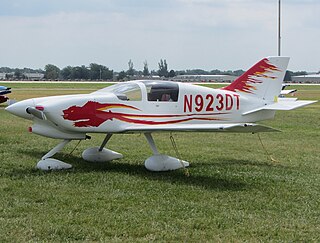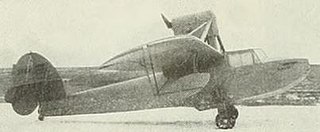Related Research Articles

The Barrows Bearhawk, now also called the Barrows 4-Place Bearhawk, is an American amateur-built aircraft, designed by Bob Barrows and produced by R&B Aircraft of Fincastle, Virginia, AviPro Aircraft and now Bearhawk Aircraft of Austin, Texas. The aircraft is supplied as a kit or as plans for amateur construction.

The CAP Aviation CAP-23x family is a family of aircraft designed for competition aerobatics. The CAP 230 airframe was a direct development of the CAP 21 competition single seater strengthened to cope with a 300 hp (220 kW) 6-cylinder Lycoming AEIO-540 engine instead of the 200 hp (150 kW) original 4-cylinder Lycoming AEIO-360.

The PZL-105 Flaming (flamingo) is a Polish short-takeoff-and-landing (STOL) utility aircraft designed by PZL "Warszawa-Okęcie". It remained a prototype.
The Koolhoven F.K.42 was a parasol-wing, two-seat training monoplane manufactured by Koolhoven in the Netherlands. Only one was built.

The Scintex ML 250 Rubis was a French civil utility aircraft of the 1960s.

The I.S.T. XL-14 Maya was a single-engine, light experimental aircraft designed and built in the Philippines in the early 1950s to investigate the use of indigenous materials in aircraft construction. Its construction uses a type of woven bamboo.

The Team Tango Tango 2 is an American low-wing composite homebuilt aircraft, marketed as a kit for amateur construction by Team Tango of Williston, Florida.

The Bushcaddy L-162 Max is a Canadian kit aircraft that was designed by Sean Gilmore and produced by Canadian Light Aircraft Sales and Service and most recently by Bushcaddy. The aircraft is supplied as a kit for amateur construction.

The Turbay T-3A was an Argentine twin-engined seven-seater light transport of the 1960s. A single example was built, but no production followed.
The Normand Dube Aerocruiser Plus is a four-seat Canadian amateur-built aircraft, designed by Normand Dube and produced by Aviation Normand Dube of Sainte-Anne-des-Plaines, Quebec. The aircraft is a development of the two-seat Norman Dube Aerocruiser.
The Wier RDW-2 Draggin' Fly was a homebuilt light aircraft, designed in the United States in the 1970s, aimed at fairly inexperienced builders and flyers. Plans were available but only one was built.
The Stephens Akro is a single engine monoplane designed in the United States for aerobatic competitions. It first flew in 1967 and proved very successful, leading to several developments of which one won seven US Championships and one World Championship between 1975 and 1982. The Extra EA-230 and Extra EA-300 were also Akro developments with over two hundred built.
The ViS Sprint is a pusher configuration, pod-and-boom two-seat ultralight, designed and built in the Ukraine in the mid-2000s. It can serve as an agricultural spraying aircraft.
The Rihn DR-109 is an American aerobatic homebuilt aircraft that was designed by Dan Rihn. The aircraft was supplied by Jim Kimball Enterprises of Zellwood, Florida and more recently by Ashcraft Aero Works of Aurora, Illinois in the form of plans. It was designed for competition aerobatics as well as a trainer for the Rihn DR-107 One Design.

The Taylorcraft F-21 is a high-wing American-built certified light aircraft developed from earlier Taylorcraft designs.

The Christavia Mk IV (Christ-in-Aviation) is a Canadian homebuilt aircraft that was designed by Ron Mason and produced by Elmwood Aviation of Frankford, Ontario. The aircraft is supplied in the form of plans for amateur construction.
The Hockaday Comet was a two-seat light civil aircraft, built in the United States before World War II but not flown until near the war's end. It failed to attract buyers and only one was completed.

The Aerial Engineering Corporation Standard 6W-3 was a commercial transport modification of the US Standard J-1 biplane military trainer aircraft, with new wings, engine and accommodation for four passengers. First flown in 1925, it was built in small numbers.

The Politechnika Warszawska PW-4 Pelikan was a motor-glider variant of the two seat Polish PW-3 Bakcyl glider. Only one flew.

The Argonaut Pirate was a 1930s, U.S., three place, single-engined pusher configuration amphibious aircraft. Only two were built.
References
- 1 2 "Asia's Aircraft Industries". Flight . Vol. 82, no. 2785. 26 July 1962. p. 136. Archived from the original on 4 May 2014.
- 1 2 3 4 Taylor, John W R (1962). Jane's All the World's Aircraft 1962–63. London: Sampson Low, Marston & Co. Ltd. pp. 73–4.